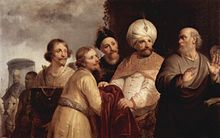How Many Troops Did the King of Syria Send Agains Elisha

Naaman (Hebrew: נַעֲמָן, "pleasantness") the Aramean was a commander of the armies of Ben-Hadad II, the king of Aram-Damascus, in the time of Joram, king of Israel.
According to the Bible, Naaman was a commander of the army of Syria. He was a good commander and was held in favor because of the victory that God brought him. Yet Naaman was a leper. Naaman's wife had a servant girl from Israel who said that a prophet there would be able to heal him. Naaman tells his lord this and he is sent to Israel with a letter to the king. The king of Israel didn't know what to do, yet Elisha (Eliseus) sent a message to the King, advising that the King tell Naaman to come to see him. Elisha then told Naaman to go bathe in the Jordan seven times and he would be clean. Naaman was angry and would have left, but his servant asked him to try it and he was healed. A servant of Elisha, Gehazi, seeing Naaman being turned away from offering God offerings, ran after him and falsely asked for clothing and silver for visitors. And the leprosy from Naaman fell on Gehazi and would remain in his descendants.
Tanakh [edit]
Naaman is mentioned in 2 Kings 5 of the Tanakh in Hebrew as "וְ֠נַעֲמָן שַׂר־ צְבָ֨א מֶֽלֶךְ־ אֲרָ֜ם" or "Naaman captain of the army of the King of Aram".
Now Naaman, the general of the king of Aram, was a prominent man before his lord and respected, for through him had the Lord given victory to Aram; and the man was a great warrior, and he was a mezora. Now the Arameans went out in bands and captured from the land of Israel a young girl, who ministered to Naaman's wife.
According to the narrative, he is called a mezora (מְּצֹרָע), a person affected by the skin disease tzaraath (צָּרַעַת, tzara'at).[1] When the Hebrew slave-girl who waits on his wife tells her of a Jewish prophet in Samaria who can cure her master, he obtains a letter from King Ben-Hadad II of Aram to King Joram of Israel in which Ben-Hadad asks Joram to arrange for the healing of his subject Naaman. Naaman proceeds with the letter to King Joram. The king of Israel suspects in this – to him – impossible request a pretext of Syria for later starting a war against him, and tears his clothes.
When the prophet Elisha hears about this, he sends for general Naaman. But rather than personally receiving Naaman when the latter arrives at Elisha's house, Elisha merely sends a messenger to the door who tells Naaman to cure his affliction by dipping himself seven times in the Jordan River. Naaman, a man of heathen faith who is unfamiliar with the Jewish mezora, had expected the prophet himself to come out to him and to perform some kind of impressive ritual magic; he angrily refuses, and prepares to go home unhealed. Only after Naaman's slaves suggest to their master that he has nothing to lose by at least giving it a try since the task is a simple and easy one, he takes his bath in the Jordan river as a mikveh as instructed and finds himself healed. (The mikveh is a bath used for ritual immersion in Judaism.)
Naaman returns to Elisha with lavish gifts, which Elisha flatly refuses to accept. Naaman also renounces his former god Rimmon after being cured by Elisha - acknowledges solely the God of Israel.[2] [3] He does, however, ask for sacrificial altar soil to be given him to take back home and that the God of Israel pardon him when he enters the temple of Rimmon as part of his obligations to the king of Syria.[4]
New Testament [edit]
Naaman is also paraphrased in Luke 4:27 of the New Testament, in Greek as "Ναιμὰν ὁ Σύρος" or "Naaman the Syrian", a leper.
There were also many lepers in Israel in the time of the prophet Elisha, and none of them was cleansed except Naaman the Syrian.'
Christian theology depicts Naaman as an example for the will of God to save people who are considered by men as less than pious and unworthy of salvation. The Septuagint, the Greek Old Testament, uses the word baptizein for the dipping that heals the heathen Naaman from the skin disease called tzaraath. The new baptism takes place in the Jordan River where Jesus of Nazareth, also called the Christ by his followers, was baptized many centuries later.
See also [edit]
- Gehazi
- Naamah (disambiguation)
- Nu'man
References [edit]
| | Wikimedia Commons has media related to Naaman. |
- ^ Often translated as leprosy, this illness or affliction, was not today's leprosy. Leprosy as known today did not come to Ancient Israel until Alexander the Great returned from his 327 to 325 BCE expedition to India.
- ^ 2 Kings 5:15 - "Then he returned to the man of God, he and all his company; he came and stood before him and said, "Now I know that there is no God in all the earth except in Israel [...]."
- ^ "God Loves Naaman". Word Journey. 29 August 2008. Archived from the original on 8 September 2008. Retrieved 7 September 2008.
- ^ 2 Kings 5:17–18
Sources [edit]
-
 This article incorporates text from a publication now in the public domain:Easton, Matthew George (1897). "Naaman". Easton's Bible Dictionary (New and revised ed.). T. Nelson and Sons.
This article incorporates text from a publication now in the public domain:Easton, Matthew George (1897). "Naaman". Easton's Bible Dictionary (New and revised ed.). T. Nelson and Sons.
Source: https://en.wikipedia.org/wiki/Naaman
0 Response to "How Many Troops Did the King of Syria Send Agains Elisha"
Post a Comment